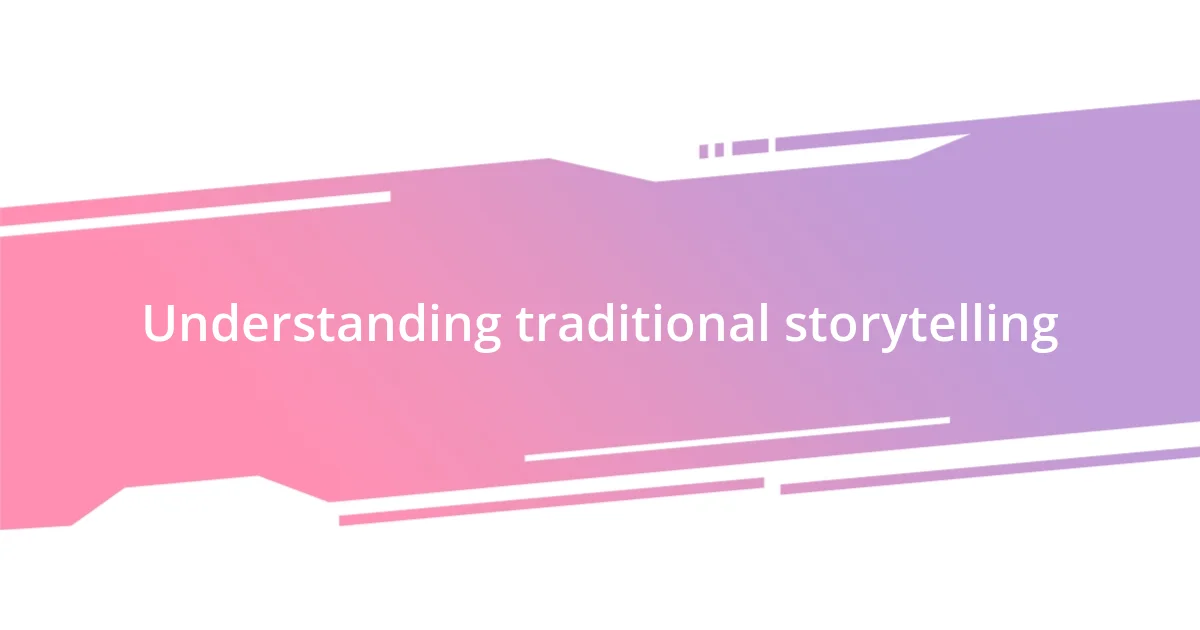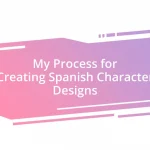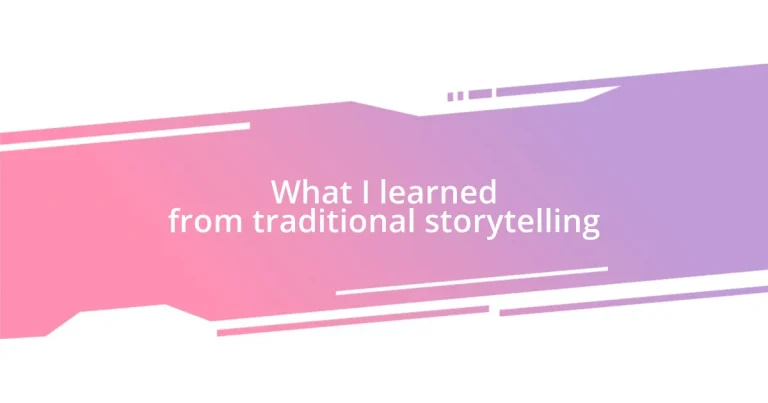Key takeaways:
- Traditional storytelling serves as a powerful tool for cultural transmission, emotional connection, and understanding complex human experiences.
- Key elements of storytelling include character development, plot structure, and setting, all of which enhance narrative richness and audience engagement.
- Modern applications of storytelling, such as in marketing and education, highlight its relevance and ability to create emotional connections and memorable experiences.

Understanding traditional storytelling
Traditional storytelling goes beyond mere entertainment; it serves as a vital means of cultural transmission. I remember listening to my grandmother share stories about our ancestors during family gatherings. Those narratives weren’t just tales—they were lessons intertwined with laughter, losses, and wisdom.
As I think back to those moments, I realize that storytelling often carries emotional weight, weaving together joy and sorrow into a tapestry of shared experience. Have you ever felt the tug of nostalgia from a story that resonated deeply with your own life? This connection is what makes traditional storytelling so powerful; it bridges generations and helps us understand our place in the world.
In essence, traditional storytelling provides a framework for understanding complex human emotions and societal norms. It’s intriguing how a simple tale can evoke such profound thoughts and feelings. Reflecting on the stories I cherished, I can see them shaping my values and worldview in ways I didn’t fully appreciate until now.

Key elements of storytelling
Key elements of storytelling are foundational aspects that give narratives depth and resonance. One of the most vital elements is character development; strong characters allow us to connect emotionally. I still remember a classic story where the hero faced dilemmas that mirrored my own struggles. Those characters felt real, almost like mentors guiding me through tough choices in my own life.
Another essential element is the plot structure, which gives a story its shape. A classic conflict-resolution arc can evoke excitement and anticipation. I’m often reminded of stories that had me holding my breath, waiting to see how the challenges unfolded. It’s this ebb and flow of tension and release that keeps readers invested, making it hard to put the book down.
Lastly, setting establishes the context and enhances the mood. When I think of the vivid forests or bustling marketplaces described in my favorite tales, I can almost feel the atmosphere enveloping me. That sensory experience transports readers to another world, fostering a deeper connection to the narrative. Each of these elements works in harmony, creating stories that linger in our hearts and minds long after they’re told.
| Element | Description |
|---|---|
| Character Development | Crafting relatable and dynamic characters that evoke emotional connections. |
| Plot Structure | Organizing events in a way that maintains tension and captures interest. |
| Setting | Creating an immersive environment that enhances the mood of the story. |

Benefits of traditional storytelling
Traditional storytelling has a unique ability to strengthen communal bonds and foster understanding. I recall attending local storytelling festivals where families gathered not just to listen but to connect with one another. Sharing our favorite tales created a sense of belonging, as if we were weaving our life experiences into a collective memory. This practice empowers both the storyteller and the audience, allowing individuals to feel valued and heard.
The benefits of traditional storytelling are multifaceted and can significantly enrich our lives. Here are some key advantages:
- Cultural Preservation: It helps maintain cultural identity and pass on ancestral wisdom to future generations.
- Enhanced Empathy: Stories evoke emotions that allow us to step into someone else’s shoes, fostering empathy and understanding.
- Critical Thinking: Engaging with narratives encourages us to analyze and interpret meaning, enhancing our critical thinking skills.
- Sharpened Communication: Storytelling hones our ability to articulate thoughts and feelings, leading to improved interpersonal skills.
- Emotional Healing: Sharing personal stories can be cathartic, providing a safe space to process grief, joy, and everything in between.
In my experience, being part of these storytelling gatherings not only enriched my understanding of others but also helped me find my voice. It was a journey of self-discovery wrapped in the warmth of shared narratives.

Techniques for effective storytelling
Effective storytelling hinges on the art of engagement, and pacing is one technique I find immensely powerful. By varying the speed at which a story unfolds—lingering on emotional beats or racing through action scenes—storytellers can manipulate audience reactions and enhance their connection to the narrative. Have you ever noticed how a slow reveal of a character’s secret can make your heart race, anticipating the fallout? I’ve felt that suspense before, where every word is a breadcrumb leading to a thrilling revelation.
Dialogue is another crucial tool I’ve come to appreciate. Authentic conversations among characters can reveal their personalities and pique audience interest. I remember a moment in a play where two characters engaged in a witty banter that reflected not just their relationship but also the tensions of the broader conflict. It was as if I was peeking into their lives, and I couldn’t help but root for them. It taught me that words can carry weight, revealing so much more than mere exposition ever could.
Lastly, vivid imagery plays a significant role in painting the world around the characters. When a storyteller crafts detailed descriptions, I can close my eyes and almost feel the warmth of a summer sun or the chilling bite of winter air. Isn’t it incredible how a well-placed metaphor can conjure such sensations? During a camping trip, I experienced this firsthand when our guide described the stars as “hundreds of fireflies trapped in a web of black velvet.” That poetic image transformed an ordinary night into an enchanting experience. Techniques like these remind me that storytelling is not just about what is told; it’s also about how it’s painted in the minds of the audience.

Incorporating personal experiences
Incorporating personal experiences into storytelling is a remarkable way to breathe life into narratives. I’ve found that when I share an experience that resonates deeply, it transforms the connection I have with my audience. For instance, recounting the time I worked through difficulties in a group project helped others relate to their own struggles, creating a shared moment that sparked honest conversations.
There’s something powerful about revealing the rawness of our emotions in stories. I remember sharing a poignant tale about the loss of a close friend during a community storytelling night. It took courage, but as I spoke, I could see nods of understanding from the crowd. Their sympathetic expressions reassured me that my vulnerability had forged a bond, making the experience not just mine, but a collective journey through grief and healing.
I often wonder why sharing our personal stories is so impactful. Why does telling the tale of my first big failure resonate with someone who has never faced the same circumstances? It’s because beneath the specific details lie universal truths about human emotions—we all crave connection and understanding. By weaving my experiences into the fabric of my stories, I’ve found that they resonate on a deeper level, drawing listeners in and inviting them to reflect on their journeys.

Modern applications of storytelling
Storytelling is omnipresent in modern media, from viral marketing campaigns to social media storytelling. I’ve seen how brands leverage engaging narratives to create emotional connections with their audiences. For example, a short commercial featuring a young girl’s journey to overcome adversity resonated with viewers on such a personal level that it sparked conversations online. Isn’t it fascinating how a simple story can transform a brand into a relatable figure in a sea of competition?
In education, storytelling serves as a powerful pedagogical tool. I recall a workshop where an educator shared historical events through the personal stories of those who lived them. This approach brought curriculum to life and made the past feel immediate and relevant, almost like I was stepping into another time. The impact was palpable; students were engaged and excited, showing that storytelling can turn lessons into memorable experiences. Can you remember a time when a story made a lesson stick in your mind far longer than simple facts ever could?
Podcasts are another compelling example where storytelling thrives today, providing a platform to share everything from personal journeys to investigative journalism. I’ve listened to episodes that unravel intricate tales of mystery or intimate conversations about failure and growth. The blend of storytelling and sound design creates an immersive experience that keeps me hooked. Have you ever felt transported by a narrative, as if you were a part of the story unfolding in your ears? That’s the magic of storytelling in the modern world—it invites us to listen, reflect, and connect in ways that are continuously evolving.

Ways to practice storytelling skills
Storytelling can be honed through practice in various ways. One effective method I’ve come across is to join a local storytelling group or club. I remember the first time I stood up to share a story about my travels; my heart raced. The feedback I received not only helped me refine my delivery but also nurtured my confidence. Engaging with others who share a passion for storytelling creates a supportive environment where everyone grows together.
Another way to sharpen storytelling skills is simply by telling stories in everyday conversations. I often find that weaving a narrative into catch-ups with friends can turn mundane discussions into memorable exchanges. Have you noticed how the tone of a conversation can shift when a story is introduced? I believe it transforms the interaction, inviting others to engage on a deeper level. The more we practice, the more intuitive it becomes to find the narrative threads in our lives.
Writing is also a powerful tool for practicing storytelling. I often keep a journal where I chronicle my experiences and reflections. This not only helps clarify my thoughts but also serves as a rehearsal for the stories I want to share. When I write down a memory, I can feel the emotions tied to it surge back, guiding me to recount it vividly later. Isn’t it incredible how putting pen to paper can unlock new layers of understanding in our own stories? It’s a method that continually reveals more about my experiences and sharpens my narrative craft.














